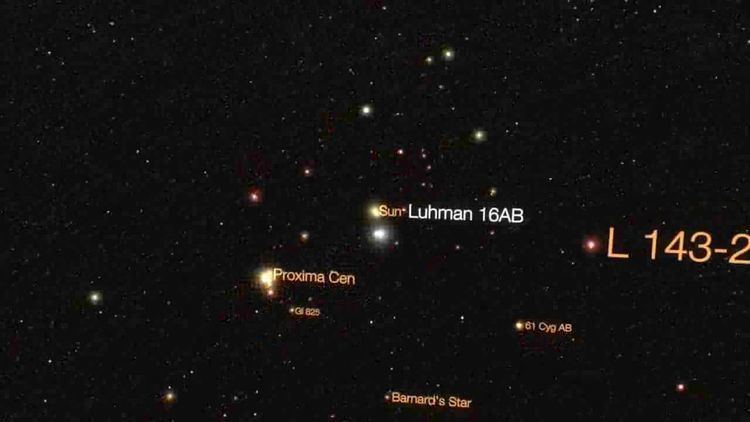 | ||
This list contains all known stars and brown dwarfs at a distance of up to 5 parsecs (16.3 light-years) from the Solar System. In addition to the Solar System, there are another 56 stellar systems currently known lying within this distance. These systems contain a total of 60 hydrogen-fusing stars (of which 50 are red dwarfs), 13 brown dwarfs, and 4 white dwarfs. Despite the relative proximity of these objects to Earth, only nine of them have an apparent magnitude less than 6.5, which means only about 12% of these objects can be observed with the naked eye. Besides the Sun, only three are first-magnitude stars: Alpha Centauri, Sirius, and Procyon. All of these objects are located in the Local Bubble, a region within the Orion–Cygnus Arm of the Milky Way.
Contents
List
Stars visible to the unaided eye have their magnitude shown in light blue below. Brown dwarfs are shown with their designations in brown. White dwarfs are shown with their designation in beige. The classes of the stars and brown dwarfs are shown in the color of their spectral types (these colors are derived from conventional names for the spectral types and do not represent the star's observed color). Many brown dwarfs are not listed by visual magnitude but are listed by near-IR J band magnitude. Some of the parallax and distance results are preliminary measurements.
Future and past
Backwards extrapolation of the motion of Gamma Microscopii has shown that approximately 3.8 million years ago, it was only around 6 light-years from the Sun. Because it is a yellow giant, it would then have had an apparent magnitude of −3, brighter than Sirius currently is.
It is estimated that Scholz's star and its companion brown dwarf passed about 52,000 astronomical units (0.25 parsecs; 0.82 light-years) from the Sun about 70,000 years ago.
Ross 248, currently at a distance of 10.3 light-years, has a radial velocity of −81 km/s. In about 31,000 years it may be the closest star to the Sun for several millennia, with a minimum distance of 0.927 parsecs (3.02 light-years) in 36,000 years. Gliese 445, currently at a distance of 17.6 light-years, has a radial velocity of −119 km/s. In about 40,000 years it will be the closest star for a period of several thousand years. Gliese 710 is currently about 63.8 light-years (19.6 parsecs) from Earth, but its proper motion, distance, and radial velocity indicate that it will approach within a very small distance—perhaps under one light year—from the Sun within 1.4 million years, based on past and current Hipparcos data. At closest approach it will be a first-magnitude star about as bright as Antares. The proper motion of Gliese 710 is very small for its distance, meaning it is traveling nearly directly in our line of sight.
In a time interval of ±10 million years from the present, Gliese 710 is the star whose combination of mass and close approach distance will cause the greatest gravitational perturbation of the Solar System.
HIP 85605's spectral type and trajectory are not fully understood. More-accurate astrometry is required to determine the distance to the star, and thus if it will pass close to the Sun. It was estimated in 2014 that HIP 85605 could approach to about 0.13 to 0.65 light-years (0.04 to 0.2 pc) from the Sun within 240,000 to 470,000 years.
Known Hipparcos stars that have passed or will pass within 5.1 light-years of the Sun within ±2 million years:
The distance to HIP 85605 was probably underestimated by a factor of ten due to it being an optical double that is particularly problematic in the Hipparcos data reduction.
